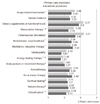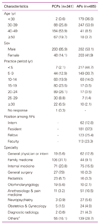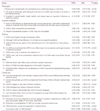1. Barnes PM, Powell-Griner E, McFann K, Nahin RL. Complementary and alternative medicine use among adults: United States, 2002. Adv Data. 2004. (343):1–19.

2. Barnes PM, Bloom B, Nahin RL. Complementary and alternative medicine use among adults and children: United States, 2007. Natl Health Stat Report. 2008. (12):1–23.

3. Xue CC, Zhang AL, Lin V, Da Costa C, Story DF. Complementary and alternative medicine use in Australia: a national population-based survey. J Altern Complement Med. 2007. 13:643–650.

4. Härtel U, Volger E. Use and acceptance of classical natural and alternative medicine in Germany: findings of a representative population-based survey. Forsch Komplementarmed Klass Naturheilkd. 2004. 11:327–334.

5. Saydah SH, Eberhardt MS. Use of complementary and alternative medicine among adults with chronic diseases: United States 2002. J Altern Complement Med. 2006. 12:805–812.

6. Artus M, Croft P, Lewis M. The use of CAM and conventional treatments among primary care consulters with chronic musculoskeletal pain. BMC Fam Pract. 2007. 8:26.

7. Corner J, Yardley J, Maher EJ, Roffe L, Young T, Maslin-Prothero S, Gwilliam C, Haviland J, Lewith G. Patterns of complementary and alternative medicine use among patients undergoing cancer treatment. Eur J Cancer Care (Engl). 2009. 18:271–279.

8. Astin JA, Marie A, Pelletier KR, Hansen E, Haskell WL. A review of the incorporation of complementary and alternative medicine by mainstream physicians. Arch Intern Med. 1998. 158:2303–2310.

9. Hsiao AF, Ryan GW, Hays RD, Coulter ID, Andersen RM, Wenger NS. Variations in provider conceptions of integrative medicine. Soc Sci Med. 2006. 62:2973–2987.

10. Lee SI, Khang YH, Lee MS, Koo HJ, Kang W, Hong CD. Complementary and alternative medicine use in Korea: prevalence, pattern of use, and out-of-pocket expenditures. Korean J Prev Med. 1999. 32:546–555.
11. Ock SM, Choi JY, Cha YS, Lee J, Chun MS, Huh CH, Lee SY, Lee SJ. The use of complementary and alternative medicine in a general population in South Korea: results from a national survey in 2006. J Korean Med Sci. 2009. 24:1–6.

12. Lee SI, Khang YH, Lee MS, Kang W. Knowledge of, attitudes toward, and experience of complementary and alternative medicine in western medicine-and oriental medicine-trained physicians in Korea. Am J Public Health. 2002. 92:1994–2000.

13. Hong CD. Complementary and alternative medicine in Korea: current status and future prospects. J Altern Complement Med. 2001. 7 Suppl 1:S33–S40.

14. Perkin MR, Pearcy RM, Fraser JS. A comparison of the attitudes shown by general practitioners, hospital doctors and medical students towards alternative medicine. J R Soc Med. 1994. 87:523–525.
15. National Health Insurance Corporation, Health Insurance Review & Assessment Service. 2008 National Health Insurance statistics. 2009. Seoul: National Health Insurance Corporation, Health Insurance Review & Assessment Service.
16. Lewith GT, Hyland M, Gray SF. Attitudes to and use of complementary medicine among physicians in the United Kingdom. Complement Ther Med. 2001. 9:167–172.

17. Hyland ME, Lewith GT, Westoby C. Developing a measure of attitudes: the holistic complementary and alternative medicine questionnaire. Complement Ther Med. 2003. 11:33–38.

18. Schneider CD, Meek PM, Bell IR. Development and validation of IMAQ: Integrative Medicine Attitude Questionnaire. BMC Med Educ. 2003. 3:5.

19. Furnham A, McGill C. Medical students attitudes' about complementary and alternative medicine. J Altern Complement Med. 2003. 9:275–284.

20. Rosenbaum ME, Nisly NL, Ferguson KJ, Kligman EW. Academic physicians and complementary and alternative medicine: an institutional survey. Am J Med Qual. 2002. 17:3–9.

21. Berman BM, Singh BB, Hartnoll SM, Singh BK, Reilly D. Primary care physicians and complementary-alternative medicine: training, attitudes, and practice patterns. J Am Board Fam Pract. 1998. 11:272–281.

22. Stange R, Amhof R, Moebus S. Complementary and alternative medicine: attitudes and patterns of use by German physicians in a national survey. J Altern Complement Med. 2008. 14:1255–1261.

23. Maha N, Shaw A. Academic doctors' views of complementary and alternative medicine (CAM) and its role within the NHS: an exploratory qualitative study. BMC Complement Altern Med. 2007. 7:17.

24. van Haselen RA, Reiber U, Nickel I, Jakob A, Fisher PA. Providing complementary and alternative medicine in primary care: the primary care workers' perspective. Complement Ther Med. 2004. 12:6–16.

25. Song MY, John M, Dobs AS. Clinicians' attitudes and usage of complementary and alternative integrative medicine: a survey at the Johns Hopkins Medical Institute. J Altern Complement Med. 2007. 13:305–306.

26. Joos S, Musselmann B, Szecsenyi J. Integration of complementary and alternative medicine into family practices in Germany: results of a national survey. Evid Based Complement Alternat Med. 2011. 2011:495813. DOI:
10.1093/ecam/nep019.

27. Burg MA, Kosch SG, Neims AH, Stoller EP. Personal use of alternative medicine therapies by health science center faculty. JAMA. 1998. 280:1563.

28. Milden SP, Stokols D. Physicians' attitudes and practices regarding complementary and alternative medicine. Behav Med. 2004. 30:73–82.

29. Levine SM, Weber-Levine ML, Mayberry RM. Complementary and alternative medical practices: training, experience, and attitudes of a primary care medical school faculty. J Am Board Fam Pract. 2003. 16:318–326.

30. Corbin Winslow L, Shapiro H. Physicians want education about complementary and alternative medicine to enhance communication with their patients. Arch Intern Med. 2002. 162:1176–1181.

31. Ock SM, Kim CM, Choi WS, Ju SY, Shin HC, Song CH. Perception and experience of CAM education for family practice residents by family practice training faculty in South Korea. J Korean Acad Fam Med. 2008. 29:932–938.









 PDF
PDF ePub
ePub Citation
Citation Print
Print



 XML Download
XML Download